18. сентября 2011 00:09
В SQL Server есть ограничение на инструкцию INSERT EXEC — она не может быть вложенной. Т.е. если в теле процедуры мы уже используем код INSERT EXEC, то рекордсет из этой процедуры мы не сможем вставить в таблицу. На Microsoft Connect есть фитбек с этой проблемой (Cannot have nested INSERT … EXEC) и совсем недавно эту проблему закрыли с пометкой as Won’t Fix.
Но, что делать, если нам все-таки необходимо вывести результат работы процедуры в таблицу? Именно тому, как обойти одно из ограничений сиквела и посвящён этот пост.
Для иллюстрации создадим тестовую БД TestDB и две процедуры, одна будет возвращать небольшой рекордсет, а во второй мы будем вызывать эту процедуру с использованием инструкции INSERT EXEC.
create database TestDB go use TestDB go if object_id ( 'dbo.TestProc01', 'P' ) is not null drop procedure dbo.TestProc01 go create procedure dbo.TestProc01 as set nocount on declare @t table ( i int ) insert into @t values (1),(2),(3) select * from @t go if object_id ( 'dbo.TestProc02', 'P' ) is not null drop procedure dbo.TestProc02 go create procedure dbo.TestProc02 as set nocount on declare @t table ( i int ) insert into @t exec dbo.TestProc01 select * from @t go
Дальше небольшой скрипт, который и эмулирует, озвученную выше, ошибку:
declare @t table ( i int ) insert into @t exec dbo.TestProc02
А теперь несколько способов обойти эту ошибку:
1) Первый и самый правильный
По возможности не использовать вложенных инструкций INSERT EXEC, либо вместо вызова процедуры, в которой уже используется такая конструкция, взять часть скрипта из тела этой самой процедуры. Как правило, это достаточно легко можно реализовать. В моём примере достаточно заменить вызов процедуры dbo.TestProc02 на dbo.TestProc01.
2) Используем OPENQUERY или OPENROWSET
Для этого нам потребуется создать Linked Server с ссылкой нашего сервера БД на самого себя ( в моём случае это IP 127.0.0.1).
use master
go
exec sp_addlinkedserver N'127.0.0.1'
, N'SQL Server';
go
use TestDB
go
declare @t table ( i int )
insert into @t
select * from OpenQuery ( [127.0.0.1], 'TestDB.dbo.TestProc02' )
select * from @t
3) Используем распределённый запрос
declare @t table ( i int ) insert into @t exec [127.0.0.1].TestDB.dbo.TestProc02 select * from @t go --либо: declare @t table ( i int ) insert into @t exec ( 'TestDB.dbo.TestProc02' ) at [127.0.0.1] select * from @t go
Не забываем включить службу Координатор распределенных транзакций Иначе получим ошибку:
4) Используем процедуру xp_cmdshell и утилиту SQLCMD
Но для начала включим использование процедуры xp_cmdshell
exec sp_configure 'show advanced options', 1 reconfigure exec sp_configure 'xp_cmdshell', 1 reconfigure go
А теперь выгружаем результат работы процедуры dbo.TestProc02 в таблицу:
declare @t table ( val varchar(100) ) insert into @t exec master..xp_cmdshell 'sqlcmd -E -q "exec TestDB.dbo.TestProc02" -h -1 -W' select val from @t where val is not null
5) Используем процедуру xp_cmdshell и утилиту BCP
--Выгружаем результат процедуры dbo.TestProc02 на диск exec xp_cmdshell 'bcp "exec TestDB.dbo.TestProc02" queryout "c:\temp\Test.txt" -T -c -C RAW -r\n -t\char(3)' --Создадим таблицу для получения результата if object_id ( 'dbo.tmpMyResult', 'U' ) is not null drop table tmpMyResult go create table tmpMyResult ( val int ) --Загружаем результат с диска в таблицу exec xp_cmdshell 'bcp TestDB.dbo.tmpMyResult in "c:\temp\Test.txt" -T -c -C RAW -r\n -t\char(3)' --Смотрим select * from tmpMyResult
6) Используем CLR
Но этот вариант я не буду рассматривать в рамках этого поста.
If you use the tSQLt unit testing framework for long enough, you will eventually run into the “An INSERT EXEC statement cannot be nested” problem. This problem happens when you try to insert the output of a stored procedure into a temporary table for validation, but that stored procedure internally already does the same thing, inserting the output of another stored procedure into a temporary table. SQL Server does not allow this.
Researching the problem will lead you to a lot of articles and posts in which people say that you must change your code, and for example use:
- Table Valued Functions
- Shared temporary tables
- Table Variables as output parameters
- Custom parameters on your stored procedures that are only applicable for testing
- Workarounds using OPENROWSET, Linked Servers or even xp_cmdshell+sqlcmd
All those solutions are hacky, and it is simply not always possible to change the underlying code. Nor should you. Code should be tested exactly how it will be executed and used in the wild, else your test is not worth much and you’ll soon have users, or worse your boss, at your desk complaining about world ending errors.
In your search for a solution, you hopefully found an article by Charles Silbergleith called tSQLt and the INSERT EXEC Problem. It is a good article. You should read it. Charles’s solution is to use a CLR. If you’ve never used a CLR before, it is just a .Net application (dll) that is imported into SQL Server and executed like a stored procedure. By using a CLR, we can execute any queries or stored procedures as if the code is being run by an external application, like it would in the real world, and capture output of the query into a temporary table for validation. But Charles’s CLR implementation is far too advanced. It is going to take hours to figure out and even longer to get it working. This article is a follow on to Charles’s work, a quick and simple CLR How-to specific to tSQLt unit testing.
In this article, we’ll setup a test scenario that throws the “An INSERT EXEC statement cannot be nested” error and then step by step build a CLR to fix it. With lots of screenshots to help you along the way. I promise, you do not need to know how to code in C#. Just follow the steps below and copy paste.
Right, let’s get started.
The Test Scenario
Let’s say for example you have a stored procedure called “ComplexBusinessCalc” which you would like to unit test. Internally your stored procedure uses other stored procedures that you absolutely cannot change. And your stored procedure works perfectly as-is when you execute it.
e.g.
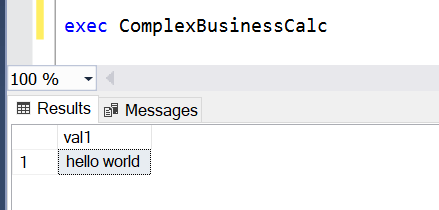
If you’d like to follow along and test out the CLR for yourself, you could use the following code to create the ComplexBusinessCalc stored procedure in your test environment.
create or alter procedure SomeReallyComplexProc
as
begin
select 'hello' as val1;
end
go
create or alter procedure ComplexBusinessCalc
as
begin
create table #tmp (val1 varchar(50));
insert into #tmp (val1)
exec SomeReallyComplexProc;
update #tmp set val1 += ' world';
select val1 from #tmp;
drop table if exists #tmp;
end
go
For your unit test, all you want to do is run the ComplexBusinessCalc stored procedure and capture its output into a temporary table for validation.
Hint: if you have not used tSQLt before, here is a good place to start.
Your tSQLt unit test could look something like this. In the test below, we are simply checking that our ComplexBusinessCalc stored procedure returns at least one row of data.
exec tSQLt.NewTestClass 'demo';
go
create or alter procedure demo.[test that ComplexBusinessCalc returns data]
as
begin
create table #test (val1 varchar(50));
insert into #test (val1)
exec ComplexBusinessCalc;
if not exists (select * from #test)
begin
exec tSQLt.Fail 'No data returned';
end
drop table if exists #test;
end
go
But when you run your unit tests, you get stuck on the annoying “An INSERT EXEC statement cannot be nested” problem.
exec tSQLt.RunAll;
Result
[demo].[test that ComplexBusinessCalc returns data] failed: (Error) Message: An INSERT EXEC statement cannot be nested. | Procedure: ComplexBusinessCalc (6) | Severity, State: 16, 1 | Number: 8164
The solution is simple. All you need to do is change one line in your unit test. Instead of executing the ComplexBusinessCalc stored procedure within the current transaction’s context, you instead pass it as a query to a CLR to execute on it a new connection not enlisted in the same transaction context as the tSQLt test. See the «exec Query» line which replaced «exec ComplexBusinessCalc». The «Query» object looks like a stored procedure, and it is, but underneath it calls a CLR.
create or alter procedure demo.[test that ComplexBusinessCalc returns data]
as
begin
create table #test (val1 varchar(50))
insert into #test (val1)
exec Query @server = @@servername, @query = 'exec Demo..ComplexBusinessCalc';
if not exists (select * from #test)
begin
exec tSQLt.Fail 'No data returned';
end
drop table if exists #test;
end
go
Hint: If you need to pre-prepare some specific data for the unit test, add those commands into the @query parameter. The SQL connection made by the CLR would not be able to read any data setup via the tSQLt unit test’s transaction unless you allow uncommitted reads. Remember to rollback afterwards.
But, we first need to go create that “Query” CLR that accepts T-SQL commands and executes those against your SQL instance as an external application on a different transaction.
Here we go. Get ready to copy paste.
Create your first CLR
Step 1: Run Visual Studio and ensure that you have the “Data storage and processing” feature set installed. You can download the Visual Studio Community Edition for FREE from https://visualstudio.microsoft.com/ . All the screenshots in this article are from Visual Studio 2022.
In Visual Studio, via the Tools menu, open the “Get Tools and Features” dialog and ensure the Data storage and processing features are installed.

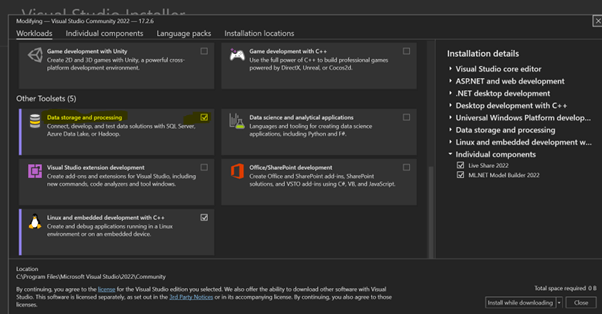
Step 2: Create a new SQL Server Database Project. You can access the Create Project dialog via the Files > New Project menu.
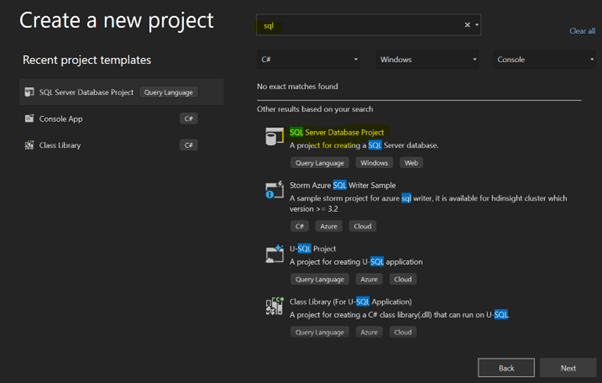
Step 3: Add a “SQL CLR C# Stored Procedure” item to your database project, by right clicking on your project inside the Solution Explorer view and selecting Add > New Item from the context menu. This will open the Add New Item dialog. Select the “SQL CLR C# Stored Procedure” template.
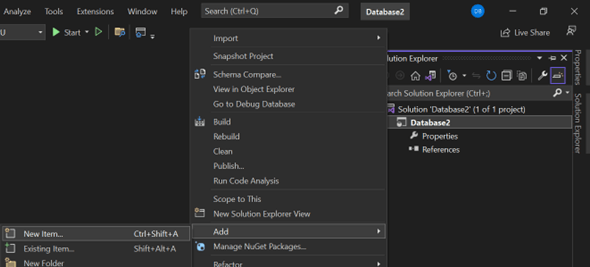
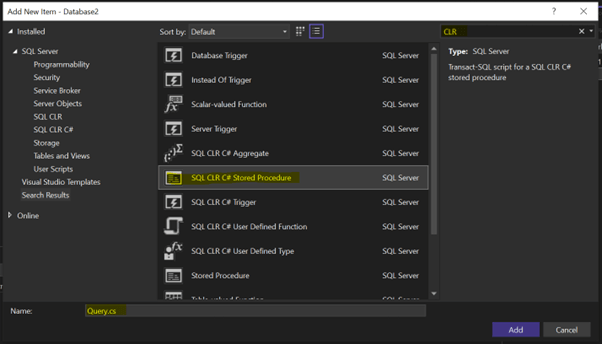
Name the new item Query.cs
The default template code inside Query.cs will look like this:
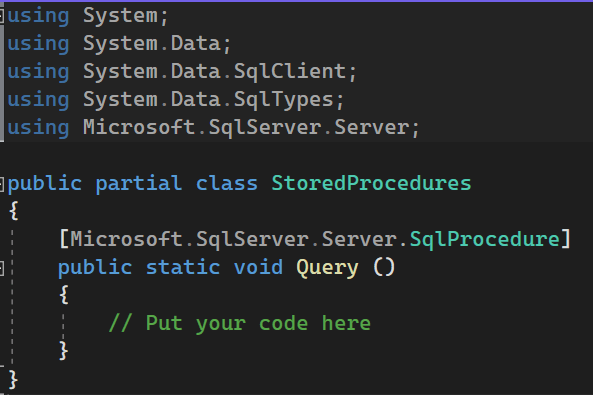
Replace all the default template code inside Query.cs with the following. Note, if you do change the SqlConnection, you must remember to keep the setting Enlist=false else the connection pooler will automatically enlist the connection in the creation thread’s current transaction context, and you’ll get the same “An INSERT EXEC statement cannot be nested” error, even when running your stored procedure via the CLR.
using System;
using System.Data;
using System.Data.SqlClient;
using System.Data.SqlTypes;
using Microsoft.SqlServer.Server;
public partial class Query
{
[Microsoft.SqlServer.Server.SqlProcedure]
public static void Exec(SqlString server, SqlString query)
{
SqlConnectionStringBuilder sb = new SqlConnectionStringBuilder
{
DataSource = server.ToString(),
IntegratedSecurity = true,
Enlist = false
};
using (SqlConnection conn = new SqlConnection(sb.ToString()))
{
conn.Open();
SqlCommand cmd = new SqlCommand(query.ToString(), conn);
SqlDataReader reader = cmd.ExecuteReader();
SqlContext.Pipe.Send(reader);
}
}
}
Step 4: Select the “Release” solution configuration from the drop down in the top toolbar in Visual Studio.
Step 5: Make the “Output” window visible in Visual Studio via the View menu.
The Output window will pop up and look like this. After you have successfully built your database project, the name and path to your new .dll will be displayed in this window.

Step 6: Build your database project by right clicking on it in the Solution Explorer view and selecting “Build” from the context menu.
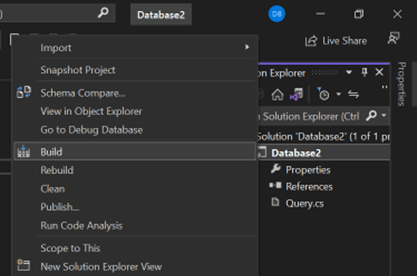
The Output window will show that your project was successfully built and the full name and path to your newly created CLR.

Step 7: Import your new CLR dll into SQL
exec sp_configure 'clr enabled', 1; reconfigure; go alter database Demo set trustworthy on; --change to your database name go use Demo --change to your database name go --change path to dll create assembly ExternalUtils from 'C:\Users\brink\source\repos\Database2\Database2\bin\Release\Database2.dll' with permission_set = external_access; go create procedure Query @server nvarchar(max) , @query nvarchar(max) as external name ExternalUtils.Query.[Exec]; go
Step 8: Test your newly created CLR. By the way, if you haven’t noticed, the CLR uses Windows Authentication (a.k.a IntegratedSecurity). You’ll have to change the SqlConnection code in the CLR if you only have SQL Authentication in your environment.

Done: That’s all folks. Now simply update your unit test to use the CLR to execute your stored procedure. After which your tSQLt unit test will run perfectly.
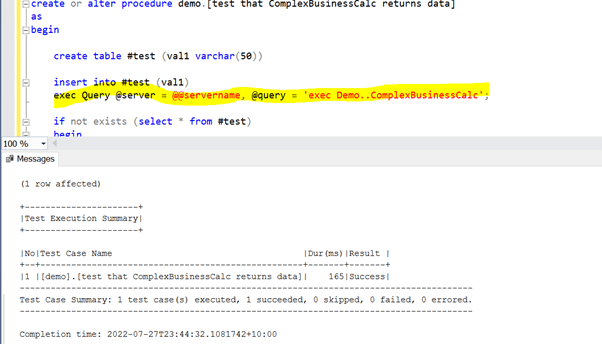
Bonus Tip
You can use the “Generate Scripts…” task in SQL Server Management Studio (SSMS) to export your CLR as a T-SQL script. This makes deployment of the CLR to other servers very easy.
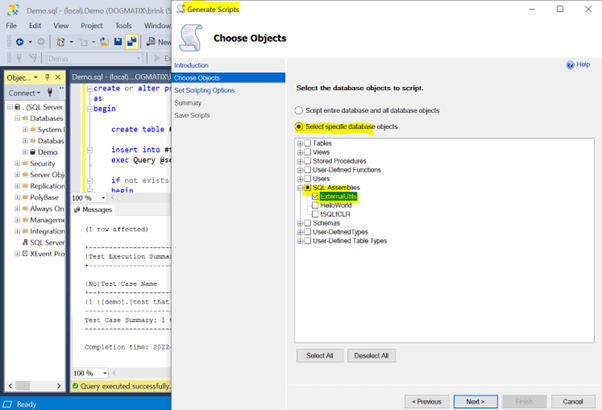
The output script will look something like this. Simply include it as-is in your deployment patches.

Have fun unit testing.
|
|
|
Julia2000 3 / 2 / 1 Регистрация: 12.05.2022 Сообщений: 24 |
||||||||
|
28.02.2023, 11:31. Показов 1977. Ответов 4 Метки нет (Все метки) Не могу понять из-за чего возникает ошибка
Сообщение 8164, уровень 16, состояние 1, процедура fs_read, строка 104 Я конечно могу в процедуре перед select последним вставить А также, как я понимаю, сделать все это в функции вообще невозможно?
0 |
|
4718 / 1442 / 506 Регистрация: 31.05.2012 Сообщений: 5,082 |
|
|
28.02.2023, 12:28 |
|
|
это ограничение (или баг?) ms sql. не используй вложение зы в сети есть способы обхода
1 |
|
uaggster 1236 / 345 / 93 Регистрация: 14.10.2022 Сообщений: 1,045 |
||||||||
|
28.02.2023, 13:19 |
||||||||
|
Сообщение было отмечено Julia2000 как решение РешениеСообщение от Julia2000 но хочется понять из-за чего ошибка… Ну, там же написано: Сообщение от Julia2000 Инструкция INSERT EXEC не может быть вложенной. У вас внутри процедуры:
И вызываете ее вы:
Так не бывает, к сожалению.
1 |
|
3 / 2 / 1 Регистрация: 12.05.2022 Сообщений: 24 |
|
|
28.02.2023, 13:32 [ТС] |
|
|
Спасибо!
0 |
|
Новые блоги и статьи
Все статьи Все блоги / |
||||
|
.NET Aspire и cloud-native приложения C#
stackOverflow 24.05.2025 . NET Aspire — новый продукт в линейке Microsoft, который вызвал настоящий ажиотаж среди разработчиков облачных приложений. Компания называет его «опинионированным, облачно-ориентированным стеком для. . . |
Python и OpenCV для распознавания и обнаружения лиц
AI_Generated 24.05.2025 Python — язык, заслуживший любовь миллионов разработчиков своей простотой и выразительностью, а OpenCV (Open Source Computer Vision Library) — библиотека компьютерного зрения с открытым исходным. . . |
Брокер NATS в C#
UnmanagedCoder 24.05.2025 NATS (Neural Autonomic Transport System) — это легковесная система обмена сообщениями, которая отлично вписывается в мир современных распределённых приложений. Если вы когда-нибудь пытались построить. . . |
Оптимизация производительности Express.js бэкенда
Reangularity 23.05.2025 Express. js заслуженно остаётся одним из самых популярных инструментов для создания бэкенда, но даже он не застрахован от проблем с производительностью. Многие разработчики сталкиваются с ситуацией,. . . |
Продвинутая обработка данных с LINQ в C#
stackOverflow 23.05.2025 LINQ (Language Integrated Query) — это фундаментальное изменение парадигмы работы с данными в C#. Простые запросы Where и Select знакомы любому разработчику, но настоящая мощь LINQ раскрывается в. . . |
|
Инфраструктура PKI и сертификатов безопасности
Mr. Docker 23.05.2025 PKI (Public Key Infrastructure) — это невидимый фундамент цифрового доверия, без которого современный интернет просто рассыпался бы как карточный домик. За этой аббревиатурой скрывается целый. . . |
Аутентификация OAuth в Python
py-thonny 22.05.2025 OAuth (Open Authorization) — это целый стандарт для делегированного доступа. Звучит занудно? Давайте проще: OAuth позволяет приложениям получать доступ к информации пользователя на сторонних сервисах. . . |
Хеширование и соль паролей в веб-приложениях C#
stackOverflow 22.05.2025 Когда-то в начале своей карьеры я тоже грешил простейшими подходами к хранению паролей – MD5-хеширование казалось верхом защиты. Но технологии не стоят на месте, вычислительные мощьности растут, и. . . |
Генераторы Python для эффективной обработки данных
AI_Generated 21.05.2025 В Python существует инструмент настолько мощный и в то же время недооценённый, что я часто сравниваю его с тайным оружием в арсенале программиста. Речь идёт о генераторах — одной из самых элегантных. . . |
Чем заменить Swagger в .NET WebAPI
stackOverflow 21.05.2025 Если вы создавали Web API на . NET в последние несколько лет, то наверняка сталкивались с зелёным интерфейсом Swagger UI. Этот инструмент стал практически стандартом для документирования и. . . |
Наверх
- Author
- Recent Posts
I started writing code around 20 years ago, and throughout the years, I have gained a lot of expertise from hands-on experience as well as learning from others. This website has also grown with me and is now something that I am proud of.
An INSERT EXEC statement cannot be nested is an error that comes up due to an SQL Server restriction that talks about the same concept. At this moment, understanding why this problem is happening is equally important as finding its solution to not only stumble upon the best procedure but also be able to avoid this annoying restriction in the future.

Thus, this post talks about the cause of the stated error in a bit more detail and presents you with premium solutions to fix the error immediately. So, don’t waste an extra second, and continue reading to see what this article has for you.
JUMP TO TOPIC
- An Insert Exec Statement Cannot Be Nested: Why Does It Occur?
- – An SQL Server Restriction Not Allowing Nested INSERT-EXEC Statements
- An Insert Exec Statement Cannot Be Nested: How To Resolve It?
- – Use the OUTPUT Parameter/Parameters
- – Don’t Use Insert-exec Statement Unnecessarily
- – Make Use of the Table-valued Functions
- – Choose Working With the CLR As the Last Option
- FAQ
- – What Does the Insert Exec Failed Error Mean?
- – What Does the Invalid Use of ‘Insert Exec’ Within a Function Mean?
- Conclusion
An Insert Exec Statement Cannot Be Nested: Why Does It Occur?
An INSERT EXEC statement cannot be nested error can occur due to an SQL Server restriction that stops the usage of the nested INSERT EXEC statement. It says that you can’t use a stored procedure with an INSERT EXEC statement inside it in an INSERT EXEC statement.
– An SQL Server Restriction Not Allowing Nested INSERT-EXEC Statements
The SQL Server poses a restriction over the usage of the nested INSERT-EXEC statements. You can’t use a stored procedure in the INSERT-EXEC statement if the stored procedure uses an INSERT-EXEC statement inside it. If you do, you’ll get an insert exec statement cannot be nested server error message.

Moreover, it is also possible that your targeted stored procedure doesn’t contain the INSERT-EXEC statement, but a stored procedure called inside it contains the same statement. In such a case, the sp_replmonitorsubscriptionpendingcmds an insert exec statement cannot be nested will pop up.
In short, no matter how deeply embedded the given statement is inside a stored procedure, the stored procedure will be restricted from being used inside an INSERT-EXEC statement.
An Insert Exec Statement Cannot Be Nested: How To Resolve It?
You can resolve an INSERT EXEC statement cannot be nested error by avoiding the extra usage of the said statement, using the output parameter or parameters, leveraging the table-valued functions, or using the CLR as the last option. In short, using an INSERT EXEC alternative will save you.
– Use the OUTPUT Parameter/Parameters
You can use the OUTPUT parameter or parameters as a nested insert exec alternative to fix the given error on your system. But there is a limitation to apply this solution. You can go with it only if the resulting data is a single row instead of a big table.
Imagine that you want a stored procedure that inserts a single row in the table, and returns the ID for the same row. Moreover, you want to call the same stored procedure from another stored procedure. In this scenario, the OUTPUT parameter will prove to be of great benefit. Plus, you won’t need to work with the nested INSERT EXEC SQL Server statement and stumble upon the mentioned error.
The code that aligns perfectly with the given situation has been provided below:
@subject nvarchar(50),
@teacher_id int OUTPUT AS
BEGIN TRANSACTION
SELECT @teacher_id = coalesce(MAX(teacher_id), 0) + 1 FROM teachers (UPDLOCK)
INSERT teachers (teacher_id, name, subject)
VALUES (@teacher_id, @name, @subject)
COMMIT TRANSACTION
Now, you can call the insert_teacher stored procedure from another stored procedure without much by following the line of code depicted below:
EXEC insert_teacher @name, @subject, @teacher_id OUTPUT
Note that it’s not necessary to restrict the number of output parameters to one. You can make your stored procedure return as many output parameters as you want. But remember that the number of resulting rows should not exceed one.
– Don’t Use Insert-exec Statement Unnecessarily
It is recommended to avoid the unnecessary usage of the INSERT-EXEC statement in your stored procedures to resolve the error provided above. It is because this way, the chances of the occurrence of the nested INSERT-EXEC will be reduced, keeping the SQL Server satisfied.
For example, it is possible for you to perform your desired task without using the INSERT-EXEC statement. In that case, it would be better to skip INSERT-EXEC because you never know when you’ll need to use your stored procedure in the INSERT-EXEC statement. As nesting the said statement isn’t allowed, you’ll have to go back to your code, and change it to replace the INSERT-EXEC statement with one of its alternatives, or remove it entirely to proceed further.
– Make Use of the Table-valued Functions
Although not all of your stored procedures can be rewritten as table-valued functions, the ones that can be rewritten will help you escape from the error discussed in this post. Consequently, you’ll be able to reuse the result set from a stored procedure successfully.

Check out the following inline function to understand the concept better:
RETURNS TABLE AS
RETURN (SELECT p.productNames, c.quantity
FROM customer c
JOIN products p ON p.product_id = c.product_id
WHERE c.customer_id = @customerid)
Here is how you can use it:
SELECT * FROM SalesByCustomer(‘6380’)
Please feel free to filter the data with the WHERE clause or use it in a larger query that includes other tables. It means that you can use the given function just the way you would use a table or a view.
Moreover, it would be safe to say that an inline function is a parameterized view. It is because the query optimizer expands the function just like a macro, and provides the plan like you have provided an expanded query. Therefore, you’ll find zero performance cost for wrapping a SELECT * from EXEC statement into an inline function.
Based on the above facts, if you want to reuse a stored procedure executing a single SELECT statement, then rewriting it into a user-defined function should be your first choice. Another thing that you can try is to move the SELECT statement into an inline function and rewrite the existing stored procedure as a wrapper on the function.
– Choose Working With the CLR As the Last Option
Although working with the CLR can be complicated as compared to the INSERT-EXEC statement, you should go for it as the last option to make the error go away. It means that if none of the other options seem to work, then using the CLR will be a great workaround.
Furthermore, you can go through the following examples to learn about the situations where CLR serves as a life-saver. Say that you are calling a stored procedure that returns various differently-structured result sets. Here, the INSERT-EXEC statement will fail to serve you, and you might like to choose CLR. Note that many system procedures in SQL Server come under the stated category.
Next, imagine that you want to call a stored procedure that can’t be called within an active transaction. In this situation, the CLR will be a better option than INSERT-EXEC, helping you perform your required operation. Besides this, the CLR will help you avoid the trouble caused by calling a stored procedure that already uses an INSERT-EXEC.
FAQ
– What Does the Insert Exec Failed Error Mean?
The insert exec failed because the stored procedure altered the schema of the target table. error means that the name of your targeted temporary table and the one created inside your stored procedure is the same. You can modify the temp table name to fix the error.
– What Does the Invalid Use of ‘Insert Exec’ Within a Function Mean?
The invalid use of a side-effecting operator ‘insert exec’ within a function. means that you can’t use a function for inserting data into a base table. However, the data insertion operation can be performed within the stored procedures by using the insert exec statement.
Conclusion
Finally, you have clearly understood the cause of an insert exec statement cannot be nested SQL Server 2014 error and got your how to use results from one stored procedure in another query resolved. Now, you can deal with the said error more confidently. Please spend a few more minutes for the below listicle to end this post.
- You should avoid the unnecessary usage of the INSERT EXEC statement in your stored procedures and choose its alternatives more often.
- The OUTPUT parameters technique will serve the best when the result set consists of a single row.
- Implementing the table-valued functions wherever possible can make your code highly efficient.
- Working with CLR is not always a bad option, and you can go with it if the INSERT EXEC is constantly failing at fulfilling your task.
Now, if you are still thinking about disabling the SQL restriction, then know that it’s not possible.
Всем известно ограничение Transact-SQL, состоящее в следующем. Есть хранимая процедура, которая возвращает таблицу. Если требуется, чтобы эта таблица участвовала в каком-либо запросе, то приходится сохранять результаты работы процедуры во временной таблице с помощью инструкции «insert into <Table Name> exec <ProcName>» Это неудобно, требуется больше кода.
К тому же инструкция «insert into <Table Name> exec <ProcName>» имеет ограничение. Многие разработчики сталкивались с такой проблемой: в коде процедуры <ProcName> уже имеется инструкция «insert into … exec …». Тогда попытка сохранить результаты <ProcName> приводит к ошибке. В сообщении говорится, что конструкция «insert into … exec …» не может быть вложенной. Можно пытаться обойти эту проблему, используя функцию openquery, которая использует в качестве связанного сервера линк, который смотрит на исходный сервер. Однако такой метод не всегда сработает: функция может завершиться с ошибкой, если в процедуре используются временные таблицы, к тому же openquery не поддерживает параметры.
Один из подходов к решению проблемы состоит в следующем. Напишем табличную функцию, которая получает в качестве параметра текстовое sql-выражение и возвращает набор записей, который возщвращает sql-код. Как известно функции имеют массу ограничений по сравнению с хранимыми процедурами. Однако в них можно применять расширенные хранимые процедуры sp_OA…
План функции таков. Через sp_OACreate мы создадим ADO-соединение и ADO-команду. Для команды инициализируем свойство CommandText нашим sql-кодом. Далее применим метод Execute, инициализировав ADO-набор записей. После этого пройдемся в цикле по набору записей, наполнив выходную таблицу.
Предварительно создадим табличную функцию, которая будет логировать возможные ошибки OLE:
if sessionproperty ( N’quoted_identifier’ ) = 0
set quoted_identifier on
go
if sessionproperty ( N’ansi_nulls’ ) = 0
set ansi_nulls on
go
if object_id ( N’dbo.ProcessOleError’, N’TF’ ) is null
exec ( N’create function dbo.ProcessOleError () returns @tab table ( i int ) as begin return end’ )
go
alter function dbo.ProcessOleError ( @step varchar ( 100 ), @obj int )
returns @tab table ( src varchar ( 300 ), descr varchar ( 300 ) )
as
begin
declare @src varchar ( 300 ), @desc varchar ( 300 )
exec sp_OAGetErrorInfo @obj, @src out, @desc out
insert into @tab ( src, descr )
values ( N’статус: ‘ + @step + N’; источник: ‘ + isnull ( @src, ‘неизвестно’ ), N’описание: ‘ + isnull ( @desc, ‘неизвестно’ ) )
return
end
go
Ниже код табличной функции dbo.GetQueryResult:
if sessionproperty ( N’quoted_identifier’ ) = 0
set quoted_identifier on
go
if sessionproperty ( N’ansi_nulls’ ) = 0
set ansi_nulls on
go
if object_id ( N’dbo.GetQueryResult’, N’TF’ ) is null
exec ( N’create function dbo.GetQueryResult () returns @tab table ( i int ) as begin return end’ )
go
alter function dbo.GetQueryResult ( @txt nvarchar ( max ) )
returns @tab table
(
col0 varchar ( 300 ),
col1 varchar ( 300 )
)
as
begin declare @res int, @conn int, @cmd int, @prop int, @propInst int, @propSearch int, @propAsync int, @ADOrs int
exec @res = sp_OACreate ‘ADODB.Connection’, @conn out
if @res <> 0
begin
insert into @tab ( col0, col1 )
select src, descr
from dbo.ProcessOleError ( N’создание соединения’, @conn )
goto GarbageCollector
end
exec @res = sp_OASETProperty @conn, ‘ConnectionString’, ‘Provider=SQLNCLI11; Server=EDYNAK\SHADOW; Database=master; Trusted_Connection=yes;’
if @res <> 0
begin
insert into @tab ( col0, col1 )
select src, descr
from dbo.ProcessOleError ( N’строка подключения’, @conn )
goto GarbageCollector
end
exec @res = sp_OAMethod @conn, ‘Open’
if @res <> 0
begin
insert into @tab ( col0, col1 )
select src, descr
from dbo.ProcessOleError ( N’открытие соединения’, @conn )
goto GarbageCollector
end
exec @res = sp_OACreate ‘ADODB.Command’, @cmd out
if @res <> 0
begin
insert into @tab ( col0, col1 )
select src, descr
from dbo.ProcessOleError ( N’создание команды’, @cmd )
goto GarbageCollector
end
exec @res = sp_OASETProperty @cmd, ‘ActiveConnection’, @conn
if @res <> 0
begin
insert into @tab ( col0, col1 )
select src, descr
from dbo.ProcessOleError ( N’соединение для команды’, @cmd )
goto GarbageCollector
end
exec @res = sp_OASETProperty @cmd, ‘CommandText’, @txt
if @res <> 0
begin
insert into @tab ( col0, col1 )
select src, descr
from dbo.ProcessOleError ( N’текст команды’, @cmd )
goto GarbageCollector
end
exec @res = sp_OACreate ‘ADODB.Recordset’, @ADOrs out
if @res <> 0
begin
insert into @tab ( col0, col1 )
select src, descr
from dbo.ProcessOleError ( N’набор записей’, @ADOrs )
goto GarbageCollector
end
exec @res = sp_OAMethod @cmd, ‘Execute’, @ADOrs out
if @res <> 0
begin
insert into @tab ( col0, col1 )
select src, descr
from dbo.ProcessOleError ( N’выполнение запроса’, @cmd )
goto GarbageCollector
end
declare @h int = 1, @data varchar ( 300 ), @obj varchar ( 300 )
declare @src varchar ( 300 ), @desc varchar ( 300 )
declare @eof bit = 0
while @eof <> 1
begin
exec @res = sp_OAGetProperty @ADOrs, ‘Fields(0).Value’, @data out
if @res <> 0
begin
insert into @tab ( col0, col1 )
select src, descr
from dbo.ProcessOleError ( N’первое поле’, @ADOrs )
goto GarbageCollector
end
exec @res = sp_OAGetProperty @ADOrs, ‘Fields(1).Value’, @obj out
if @res <> 0
begin
insert into @tab ( col0, col1 )
select src, descr
from dbo.ProcessOleError ( N’второе поле’, @ADOrs )
goto GarbageCollector
end
insert into @tab ( col0, col1 )
values ( @data, @obj )
exec @res = sp_OAMethod @ADOrs, ‘MoveNext’, null
if @res <> 0
begin
insert into @tab ( col0, col1 )
select src, descr
from dbo.ProcessOleError ( N’переход на строку’, @ADOrs )
goto GarbageCollector
end
exec @res = sp_OAGetProperty @ADOrs, ‘EOF’, @eof out
if @res <> 0
begin
insert into @tab ( col0, col1 )
select src, descr
from dbo.ProcessOleError ( N’признак окончания набора’, @ADOrs )
goto GarbageCollector
end
end
GarbageCollector:
exec sp_OADestroy @conn
exec sp_OADestroy @cmd
exec sp_OADestroy @prop
exec sp_OADestroy @propInst
exec sp_OADestroy @propSearch
exec sp_OADestroy @propAsync
exec sp_OADestroy @ADOrs
return
end
go
Испытаем функцию. Например, для того чтобы получить список всех объектов всех баз данных одним запросом, можно использовать такой код:
select *
from dbo.GetQueryResult
( ‘
declare @sql nvarchar ( max ) = N»», @name nvarchar ( max )
declare cur cursor local static forward_only for
select name
from sys.databases
where database_id > 4
open cur
fetch next from cur into @name
while @@fetch_status = 0
begin
set @sql = @sql + case when @sql = N»» then N»» else N» union all » end + N»
select »»» + @name + »»», name collate Cyrillic_General_CI_AI
from » + quotename ( @name ) + ».sys.tables
»
fetch next from cur into @name
end
close cur
deallocate cur
exec sp_executesql @sql
‘)
Теперь можно использовать этот запрос для соединения с другими таблицами, вставками в таблицы. Можно передать в паметр функции и sql-выражение, содержащее вызов любой процедуры с параметрами, возвращающей набор записей. В коде функции я для примера сделал возврат только двух столбцов. При необходимости можно добавить большее число столбцов. Для работы функции на серверном компьютере должна быть установлена библиотека Microsoft ActiveX Data Objects.
